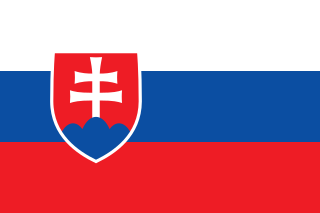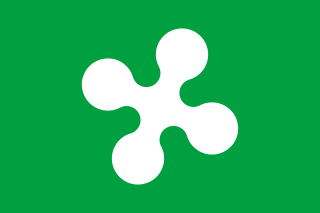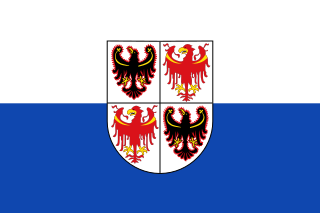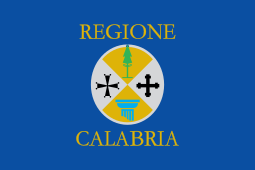
The flag of Europe or European flag consists of twelve golden stars forming a circle on a blue field. It was designed and adopted in 1955 by the Council of Europe (CoE) as a symbol for the whole of Europe.

The national flag of France is a tricolour featuring three vertical bands coloured blue, white, and red. It is known to English speakers as the Tricolour, although the flag of Ireland and others are also so known. The design was adopted after the French Revolution, where the revolutionaries were influenced by the horizontally striped red-white-blue flag of the Netherlands. While not the first tricolour, it became one of the most influential flags in history. The tricolour scheme was later adopted by many other nations in Europe and elsewhere, and, according to the Encyclopædia Britannica has historically stood "in symbolic opposition to the autocratic and clericalist royal standards of the past".

The current flag of the Australian Capital Territory was officially adopted by the Australian Capital Territory Legislative Assembly in 1993.

The current form of the national flag of the Slovak Republic was adopted by Slovakia's Constitution, which came into force on 3 September 1992. The flag, like many other flags of Slavic nations, uses Pan-Slavic colors. Pictured in the centre of the flag is Slovakia's national coat of arms.

The official coat of arms of Grenada is a shield divided into four parts by a golden cross. In the centre of this cross is the Santa Maria, Columbus' flagship. A lion passant guardant on a red field is shown in the upper left and lower right sections of the shield, with a golden crescent moon out of which a lily grows in the upper right and lower left sections. Above the shield there is a golden helmet, topped with a garland of bougainvillea branches. Within the garland are seven red roses, which stand for the seven communities of Grenada. Holding the shield on the dexter side is a nine-banded armadillo which stands before a corn stalk; on the sinister side is a Grenada dove, which stands before a banana plant. The base represents Mount St. Catherine with the Grand Etang Lake at the centre. A ribbon displays the national motto: "Ever conscious of God we aspire, build and advance as one people."

Martinique, a région and overseas département of France in the Caribbean, has historically used a coat of arms with four white fer-de-lance vipers since 4 August 1766. However, the coat of arms has become controversial due to its association with the territory's history of slavery, and its use has been discouraged by local Martinicans. The Regional Assembly has adopted a distinctive logo to represent the Territorial Collectivity of Martinique.

On 2 June 1992, the Nagorno-Karabakh Republic (NKR), a breakaway state in the South Caucasus region, adopted a flag derived from the flag of Armenia, to which a white, five-toothed, stepped carpet pattern is added, beginning at the two verges of the flag's fly and meeting at a point equal to one-third of the distance from that side. The NKR was renamed the Republic of Artsakh in 2017 after a referendum and has retained the flag.

The flag of Liguria is one of the official symbols of the region of Liguria, Italy. The current flag was adopted on 7 July 1997.

The flag of Apulia is one of the official symbols of the region of Apulia, Italy. The current flag was adopted on 10 August 2001, but was modified in 2011 after the formation of the province of Barletta-Andria-Trani in 2009.

The flag of Piedmont is one of the official symbols of the region of Piedmont in Italy. The current flag was adopted on 24 November 1995.

The flag of Umbria is one of the official symbols of the region of Umbria, Italy. The current flag was officially adopted on 18 March 2004, although the emblem and gonfalon had been in use since the 1970s. The Regional Law of 18 May 2004 officially confirmed the flag and added the words Regione Umbria in red, centered in the bottom fifth of the flag, but in common usage, the words are omitted.

The flag of Abruzzo is one of the official symbols of the region of Abruzzo, Italy. The current flag was adopted on 21 May 1999.

The flag of Basilicata is one of the official symbols of the region of Basilicata, Italy. The current flag was adopted on 6 April 1999.

The flag of Emilia-Romagna is one of the official symbols of the region of Emilia-Romagna, Italy. The flag shows the coat of arms adopted in 1989 in the variant with green writing and red bar on a white background.

The flag of Lazio is one of the symbols of the region of Lazio, Italy. The flag is currently only de facto official, but is in common use.

The flag of Lombardy is one of the official symbols of the region of Lombardy, Italy. The current flag was officially adopted on 4 February 2019, although it has been used de facto since 12 June 1975.

The flag of Molise is one of the official symbols of the region of Molise, Italy.

The flag of Trentino-Alto Adige consists of a coat of arms, containing two eagles of San Venceslao (Trentino) and two Tyrolean red eagles, historical symbols of the two provinces, which stand out against a white and blue background. The shape of the flag is a rectangle with a framed heraldic shield on it. Like other flags, the flag of Trentino-Alto Adige is also inspired, albeit differently, by the French flag introduced with the revolution of 1789. When Napoleon's army crossed Italy, starting from March 1796, flags of tricolour style were adopted both by the various newborn Jacobin republics and by the military units that supported the French army. In the Alpine region, however, sketches of the two-tone known today began to emerge. Trentino-Alto Adige has been a region with a special statute since 1948. The two parts that make it up, the Province of Trento and the Province of Bolzano, in turn, constitute two provinces with particular prerogatives of autonomy defined in 1972. The white-blue flag, in use (limited) since 1995, takes up the characteristics of the banner, including the shield with quartered eagles from the province of Trento and that of Bolzano. White and blue are the colours on which the coats of arms of Trento and Bolzano respectively were worn in ancient times. It has never been legally defined, unlike the coat of arms and the banner, approved on 17 September 1982 and approved by presidential decree of 21 March 1983.

The flag of Tuscany is the official flag of the region of Tuscany, Italy. The flag depicts a silver Pegasus rampant on a white field between two horizontal red bands. The flag first appeared as a gonfalon on 20 May 1975 along with accompanying text Regione Toscana above the Pegasus. It was officially adopted as the flag of Tuscany on 3 February 1995.

The coat of arms of Lower Silesia, and simultaneously of Silesia, shows a black eagle with silver crescent with cross in the middle on its chest on a golden background. It has been assumed in the tradition that the coat of arms and colors of Lower Silesia are simultaneously used as symbols of Silesia as a whole.






















